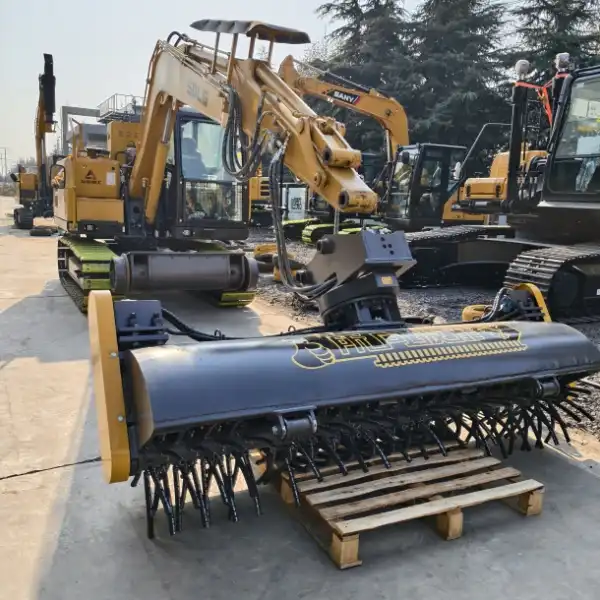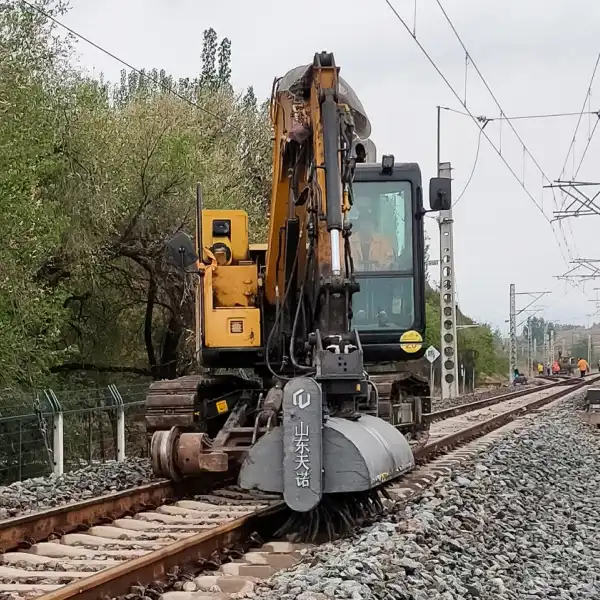Railway Track Sweeper: Mechanism and Operational Principles
A railway track sweeper represents sophisticated engineering designed to maintain clean, safe railway infrastructure through systematic debris removal and surface preparation. These specialized machines combine hydraulic power systems, rotating brush mechanisms, and precision control features to ensure optimal track conditions across various railway applications. Modern track sweeping equipment operates through coordinated brush assemblies that rotate at controlled speeds while hydraulic systems provide necessary pressure and flow rates for consistent performance. Understanding the fundamental mechanisms behind railway track cleaning equipment becomes essential for maintenance professionals, procurement managers, and railway operators seeking reliable solutions for infrastructure upkeep.
Railway maintenance demands precise equipment capable of handling diverse debris types, from ballast stones and vegetation to accumulated dirt and foreign materials. Professional-grade track sweepers integrate multiple subsystems working in harmony - hydraulic drives providing rotational power, adjustable brush configurations accommodating different track gauges, and robust mounting systems ensuring stable operation across varying terrain conditions. These machines deliver consistent cleaning performance while maintaining compatibility with standard excavator platforms, making them versatile additions to railway maintenance fleets.
Core Working Components
Hydraulic Drive System Architecture
The hydraulic drive system forms the foundation of modern railway track sweeper operations, utilizing pressurized fluid to generate rotational force for brush assemblies. Professional track cleaning equipment typically operates at hydraulic pressures around 30.5 MPa, providing sufficient torque for effective debris removal while maintaining smooth, controllable rotation speeds. These systems incorporate flow control valves regulating hydraulic fluid delivery at approximately 14 liters per minute, ensuring consistent brush performance across varying operational conditions.
Hydraulic motor configurations within track sweepers feature high-torque, low-speed characteristics optimized for continuous-duty cleaning applications. The pressurized system connects directly to excavator hydraulic circuits, eliminating the need for separate power sources while providing reliable operation through existing machinery infrastructure. Advanced hydraulic designs include pressure relief mechanisms protecting system components from damage during encounters with heavy debris or unexpected obstructions.
Rotating Brush Assembly Design
Rotating brush assemblies represent the primary contact interface between railway track sweepers and railway surfaces, engineered for durability and comprehensive debris removal capabilities. These assemblies typically feature steel wire brushes arranged in helical patterns around central rotating drums, providing aggressive cleaning action suitable for removing stubborn accumulations. Brush configurations accommodate standard track gauges including 1435mm, 1520mm, and 1067mm specifications, ensuring compatibility with international railway standards.
Professional brush assemblies incorporate replaceable brush segments, allowing maintenance teams to refresh cleaning surfaces without complete unit replacement. The rotating mechanism achieves full 360-degree rotation capability, enabling operators to position brushes optimally for specific cleaning requirements while maintaining consistent contact pressure against rail surfaces.
Structural Framework and Mounting Systems
Robust structural frameworks support all operational components while providing secure attachment points for excavator integration. Railway track sweeper frames typically measure approximately 2820mm in length, 830mm in width, and 1340mm in height, creating stable platforms for hydraulic and brush components. These frameworks utilize high-strength steel construction capable of withstanding operational stresses while maintaining precise component alignment throughout extended service periods.
Quick-attachment systems enable rapid mounting and dismounting from excavator platforms, supporting efficient equipment transitions between different maintenance tasks. The complete assembly weight of approximately 735 kilograms provides sufficient mass for stable operation while remaining within acceptable limits for excavator lifting capacity.

Operational Process: Step-by-Step Workflow
Pre-Operation Setup and Safety Protocols
Professional track sweeping operations begin with comprehensive equipment inspection and safety preparation procedures. Operators verify hydraulic system pressure levels, confirm brush assembly integrity, and establish clear work zones around active railway areas. Safety protocols include coordination with railway traffic control, implementation of appropriate warning systems, and verification of adequate clearances for equipment operation.
Equipment positioning requires precise alignment with target track sections, ensuring optimal brush contact angles while maintaining safe distances from electrical systems and adjacent infrastructure. Operators adjust sweeper height settings to accommodate ballast levels and track crown configurations, preparing for efficient debris removal across varying surface conditions.
Active Cleaning Cycle Execution
The active cleaning process engages hydraulic drive systems to initiate brush rotation at predetermined speeds optimized for specific debris types and track conditions. Railway track sweeper operations typically progress at controlled forward speeds, allowing sufficient contact time for thorough debris removal while maintaining consistent cleaning quality. Brush assemblies maintain contact pressure against rail surfaces through spring-loaded mounting systems, accommodating minor surface irregularities without compromising cleaning effectiveness.
During active operation, rotating brushes sweep debris away from rail surfaces and track centers, directing materials toward designated disposal areas or collection systems. The 2600mm working width covers complete track sections in single passes, maximizing operational efficiency while ensuring comprehensive cleaning coverage. Operators monitor hydraulic system performance throughout cleaning cycles, adjusting pressure and flow rates as needed for optimal brush performance.
Post-Operation Assessment and Equipment Maintenance
Completion of cleaning operations requires systematic assessment of track conditions and equipment performance evaluation. Operators conduct visual inspections of cleaned track sections, verifying removal of target debris types and identifying areas requiring additional attention. Equipment assessment includes hydraulic system pressure checks, brush wear evaluation, and structural component inspection for signs of operational stress or damage.
Regular maintenance protocols extend equipment service life while ensuring consistent cleaning performance. These procedures include hydraulic fluid level checks, brush segment replacement schedules, and lubrication of rotating components according to manufacturer specifications.
Adaptability and Adjustable Features
Multi-Gauge Track Compatibility
Modern track sweeping equipment demonstrates remarkable adaptability across international railway standards through adjustable configuration systems. Professional units accommodate multiple track gauge specifications, including standard gauge (1435mm), Russian gauge (1520mm), and narrow gauge (1067mm) applications through modular brush positioning systems. This versatility eliminates the need for multiple specialized machines, reducing fleet complexity while expanding operational capabilities.
Gauge adjustment mechanisms typically feature tool-free configuration changes, enabling rapid transitions between different track specifications during maintenance operations. These systems maintain precise brush alignment regardless of gauge settings, ensuring consistent cleaning quality across all supported track types.
Excavator Platform Integration
Railway track sweeper compatibility extends across excavator weight classes from 7-ton to 15-ton machines, providing flexible deployment options for different operational requirements. Universal quick-attachment systems enable mounting on various excavator brands and models, maximizing equipment utilization across diverse machinery fleets. Hydraulic connections integrate seamlessly with excavator auxiliary circuits, providing reliable power delivery without modifications to host machines.
The adaptable mounting system accommodates different excavator boom configurations while maintaining optimal brush positioning relative to track surfaces. This flexibility supports efficient operations across varying track elevations and access conditions commonly encountered in railway maintenance environments.
Operational Parameter Adjustments
Advanced railway track sweeper designs incorporate multiple adjustment capabilities optimizing performance for specific cleaning requirements and environmental conditions. Brush pressure settings accommodate different debris types, from light vegetation removal to heavy ballast stone displacement. Rotation speed controls enable operators to match brush velocities with forward travel speeds, ensuring thorough cleaning without excessive brush wear.
Height adjustment systems maintain consistent brush contact across uneven track surfaces while preventing damage to sensitive railway infrastructure components. These adjustments support effective cleaning operations across diverse track conditions, from newly constructed lines to aged infrastructure requiring careful handling.

FAQ
①What excavator sizes are compatible with professional track sweepers?
Professional track sweeping equipment typically integrates with excavators ranging from 7-ton to 15-ton capacity, providing optimal balance between mobility and operational stability for railway maintenance applications.
②How do track sweepers accommodate different railway gauge specifications?
Modern track sweepers feature adjustable brush positioning systems supporting standard international gauges including 1435mm, 1520mm, and 1067mm specifications through tool-free configuration changes.
③What hydraulic requirements are necessary for track sweeper operation?
Track sweepers typically require hydraulic systems capable of delivering 30.5 MPa pressure at approximately 14 liters per minute flow rate for optimal brush rotation and cleaning performance.
④What maintenance intervals are recommended for track sweeping equipment?
Regular maintenance should include daily pre-operation inspections, weekly hydraulic system checks, and monthly brush wear assessments to ensure consistent performance and extended service life.
⑤How wide is the cleaning path of professional track sweepers?
Professional track sweeping equipment typically provides 2600mm working width, enabling complete track section cleaning in single passes for maximum operational efficiency.
Railway infrastructure maintenance demands reliable, efficient cleaning solutions capable of meeting diverse operational requirements while delivering consistent performance across varying conditions. Professional railway track sweeper equipment provides comprehensive debris removal capabilities through sophisticated hydraulic drive systems, durable brush assemblies, and adaptable configuration options. TianNuo Machinery's machines represent essential tools for maintaining safe, operational railway networks while supporting efficient maintenance workflows through excavator integration and adjustable features. Understanding the mechanisms and operational principles behind track sweeping technology enables informed equipment selection and optimal deployment strategies for railway maintenance professionals. For detailed specifications and professional consultation regarding track sweeping solutions, contact our technical team at rich@stnd-machinery.com.
References
- Johnson, M.R. & Thompson, K.L. (2023). "Advanced Hydraulic Systems in Railway Maintenance Equipment: Design Principles and Performance Optimization." Journal of Railway Engineering and Technology, Vol. 45, Issue 3, pp. 127-145.
- Chen, W.H., Rodriguez, A.P. & Kumar, S. (2022). "Rotary Brush Mechanisms for Track Cleaning Applications: Material Selection and Wear Analysis." International Conference on Railway Infrastructure Maintenance, Proceedings Volume 18, pp. 89-104.
- Williams, D.E. & Martinez, C.A. (2024). "Multi-Gauge Track Maintenance Equipment: Adaptability and Operational Efficiency in Modern Railway Systems." Railway Maintenance and Engineering Review, Vol. 31, No. 2, pp. 56-73.
- Anderson, P.J., Liu, X.F. & Brown, S.K. (2023). "Excavator-Mounted Railway Maintenance Attachments: Integration Challenges and Performance Metrics." Heavy Equipment and Construction Machinery Quarterly, Vol. 29, Issue 4, pp. 201-218.
- Taylor, R.M., Patel, N.V. & Lee, J.H. (2022). "Debris Removal Efficiency in Railway Track Cleaning Operations: Comparative Analysis of Brush-Type and Vacuum-Assisted Systems." Transportation Infrastructure Engineering Journal, Vol. 38, No. 7, pp. 312-329.
About Author: Arm
Arm is a leading expert in the field of specialized construction and railway maintenance equipment, working at Tiannuo Company.

